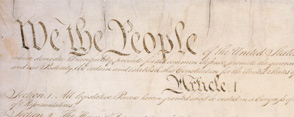 The Declaration of Independence set out our fledgling nation's political philosophy. It contains one of the most famous sentences in history: "We hold these truths to be self-evident, that all men are created equal, that they are endowed by their Creator with certain unalienable Rights, that among these are Life, Liberty and the pursuit of Happiness." In one page, Thomas Jefferson wrote an explanation to the world of why it was necessary for the former colonies to separate from Great Britain. Important ideas in the Declaration are that government exists to secure the rights of the people and that it derives its power from the consent of the governed. If this is not the case, the people have the right to abolish that government, or break ties with it.
The Declaration of Independence set out our fledgling nation's political philosophy. It contains one of the most famous sentences in history: "We hold these truths to be self-evident, that all men are created equal, that they are endowed by their Creator with certain unalienable Rights, that among these are Life, Liberty and the pursuit of Happiness." In one page, Thomas Jefferson wrote an explanation to the world of why it was necessary for the former colonies to separate from Great Britain. Important ideas in the Declaration are that government exists to secure the rights of the people and that it derives its power from the consent of the governed. If this is not the case, the people have the right to abolish that government, or break ties with it.
In addition to being a statement of independence, the Declaration can also be seen as a statement of social interdependence. "The Declaration of Independence was primarily a declaration of interdependence with the other powers of the earth. It marked the entry of one people, constituted into thirteen states, into what we would now call international society" (Armitage, n.d., par. 6).
July 4, 1776, the date the Declaration of Independence was signed by John Hancock, the president of the Continental Congress, and declared effective by Congress, is considered the birth date of our nation.
Read more about the Declaration of Independence here.
http://www.ushistory.org/us/13a.asp
The direct antecedent to our Constitution was the Articles of Confederation, a document stemming in part from the realization that a centralized form of government would be helpful in coordinating the Revolutionary War. After the Declaration of Independence was signed in 1776, members of the Continental Congress, a temporary body, realized it was time for a permanent national government. In October 1777, Continental Congress delegates formulated the Articles of Confederation, which set up state-by-state voting and proportional taxing based on land values. "The Articles created a sovereign, national government, and as such limited the rights of the states to conduct their own diplomacy and foreign policy" (Milestones, n.d., par. 9). However, the loose confederation of states set up by the Articles had inherent weaknesses that prevented effective responses to problems such as internal unrest and the tendency of individual states to ignore treaties. The value of currency varied by state, which affected trade, while the federal government, such as it was, did not have the power to tax and became mired in debt. Eventually, the early leaders of our country realized the need for a stronger central government.
For a more in-depth look at how the Articles of Confederation were drawn up, click the link below.